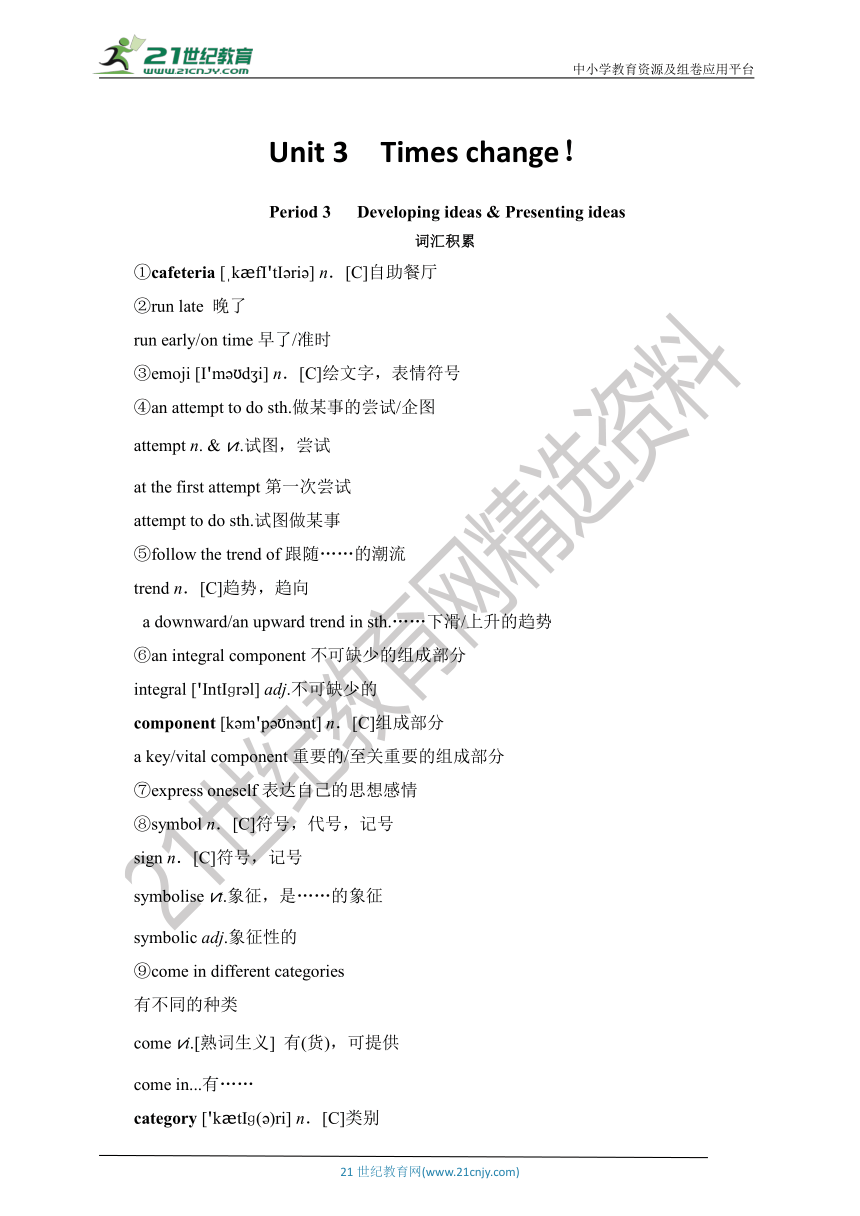
中小学教育资源及组卷应用平台 Unit 3 Times change! Period 3 Developing ideas & Presenting ideas 词汇积累 ①cafeteria [ k fI'tI ri ] n.[C]自助餐厅 ②run late 晚了 run early/on time早了/准时 ③emoji [I'm d i] n.[C]绘文字,表情符号 ④an attempt to do sth.做某事的尝试/企图 attempt n. & vt.试图,尝试 at the first attempt第一次尝试 attempt to do sth.试图做某事 ⑤follow the trend of跟随……的潮流 trend n.[C]趋势,趋向 a downward/an upward trend in sth.……下滑/上升的趋势 ⑥an integral component不可缺少的组成部分 integral ['IntIɡr l] adj.不可缺少的 component [k m'p n nt] n.[C]组成部分 a key/vital component重要的/至关重要的组成部分 ⑦express oneself表达自己的思想感情 ⑧symbol n.[C]符号,代号,记号 sign n.[C]符号,记号 symbolise vt.象征,是……的象征 symbolic adj.象征性的 ⑨come in different categories 有不同的种类 come vi.[熟词生义] 有(货),可提供 come in...有…… category ['k tIɡ( )ri] n.[C]类别 ⑩be limited to被限制在…… limit vt.限制,限定 expand upon 详述,充分叙述 the word of the year年度热词 the man/woman/of the year年度最优秀人物 pictograph ['pIkt ɡrɑ f]n.[C]象形图,图画文字 have advantages over比……有优势 emotional [I'm ( )n l] adj.情绪(上)的,情感(上)的 emotion n.[C,U]情感,情绪 gesture ['d est ] n.[C,U]手势,姿势 facial expressions面部表情 facial adj.脸上的,面部的 a string of 一串…… separation n.[U,sing.]分开,分离;[C]离别 separate vt.& vi.(使)分离,分散 separate A from/and B把A与B分开 spread to蔓延至,扩散到 textspeak ['tekst spi k]n.[U]短信简写语 intention [In'ten ( )n]n. [C,U]意图,目的 adaptation [ d p'teI ( )n] n.[C]改编 accessible [ k'sesIb( )l] adj.容易理解的,易懂的 take away拿走,带走,使消失 heart and soul精髓 soul [s l] n.[U]精神 have a tendency to do sth.有做某事的趋势 tendency ['tend nsi] n.[C]趋势,倾向 facilitate [f 'sIlIteIt] vt.促进,使便利 facilitation n.[U, sing.]简易化,简便化,促进 educator ['edj keIt ] n.[C]教育工作者,教育学家 pictorial[pIk't ri l]adj.图画的,照片的 Emojis:a new language [1]While waiting outside the cafeteria① , I received the following message from my friend : [1]此处是时间状语从句“While I was waiting outside the cafeteria”的省略形式 。 It took me a minute before I realised what it meant. The signs he used were to say that he'd be running late② and would be there soon. Instead of replying with a simple “OK, don't rush”, I searched for emojis③ on my phone that would express the same message: This was my attempt to④ follow the trend of⑤ communicating with emojis. Emojis are used everywhere, from text messages to emails, blogs and other social media networks. With the rapid development of social media, emojis are becoming an integral component⑥ of the language we use to express ourselves⑦. The word “emoji” comes from Japanese, literally meaning “picture character”. Emojis are small symbols⑧ representing ideas, emotions or feelings. They come in different categories⑨, such as faces and people, plants and animals, and food and drink. When first introduc ... ...
~~ 您好,已阅读到文档的结尾了 ~~